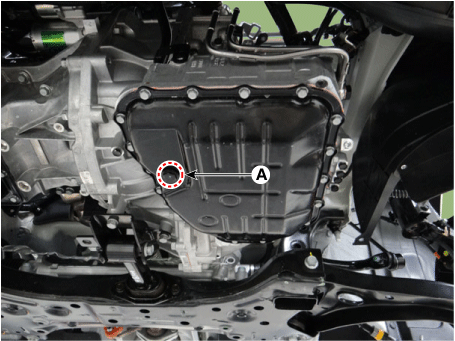Kia Rio: Engine Oil and Filter / Fluid (ATF)
Repair procedures
Automatic Transaxle
Fluid (ATF) Level Check
| 1. |
Place the vehicle on a level ground.
|
| 2. |
Start the engine to warm up the ATF.
|
| 3. |
Check by using KDS/GDS that the temperature of the ATF is between 70°C
and 80°C (158 - 176°F).
|
| 4. |
Move the shift lever slowly from "P" to "D", then back to "P". Repeat
this sequence a total of two times and then move the shift lever to "N"
range.
|
| 5. |
Remove the oil level gauge (A).

|
| 6. |
Check that the fluid level is in the "HOT" mark on the oil level gauge.
If fluid level is low, add automatic transaxle fluid until the level reaches
the "HOT" mark.
|
Recommended : - ATF SP-Ⅲ
·Recommended transaxle fluid : SK ATF SP-III, MICHANG ATF SP-III,
NOCA ATF SP-III
Capacity : 6.8 L (1.8 U.S gal., 7.2 U.S.qt., 5.98 Imp.qt.)
|
|
If the fluid smells as if it is burning, it means that the fluid
has been contaminated by fine particles from the bushes and friction
materials, a transaxle inpection may be necessary.
|
|
| 1. |
Start the engine.
|
The engine should be stopped within one minute after it is started.
If the fluid has all drained out before then, the engine should
be stopped at that point.
|
|
| 2. |
Remove the ATF drain plug (A), allow the fluid to drain out and then
reinstall the drain plug.
|
Tightening torque :
39.2 - 49.0 N·m (4.0 - 5.0 kgf·m, 28.9 - 36.2 lb·ft)
|

|
| 3. |
Refill the ATF through the ATF filler tube after removing the oil level
gauge (A).

|
You should be stop the pouring when if the full volume of fluid
can not be poured. Then start the engine and run it at idle for
1 - 2 minutes in the N or P position. Then pouring the oil after
turning off the engine.
|
|
| 4. |
Drive the vehicle until the fluid temperature rises to 70 - 80°C (158
- 176°F), and then check the fluid level again. The fluid level must be
at the HOT mark.
|
Repair procedures
Inspection
1.
Visually check the pipes, hangers and connections for severe corrosion,
leaks or damage.
2.
Check for unusual ...
Repair procedures
Replacement
1.
Turn ignition switch OFF and disconnect the negative (-) battery terminal.
2.
Remove the battery.
(Refer to Engi ...
Other information:
Repair procedures
Inspection
Manual Transaxle Oil
Level Check
1.
Stop the engine and then raise the vehicle using the lift.
2.
Remove the oil filler plug (A).
3.
Check the condition of the oil and make sure t ...
When FCA is not working properly, FCA warning light ()
will illuminate and the warning message (“Check FCA system”) will appear for
a few seconds. After the message disappears, the master warning light ()
will illuminate. In this case, have the vehicle inspected by an authorized Kia ...
 Exhaust System
Exhaust System Fuel Filter (For Diesel engine only)
Fuel Filter (For Diesel engine only)


